Influences of Slenderness and Eccentricity on the Mechanical Properties of Concrete-Filled GFRP Tube Columns
Abstract
:1. Introduction
2. Experimental Work
2.1. Test Specimens
2.2. Material Properties
2.2.1. Concrete
2.2.2. Steel Bars
2.2.3. GFRP Tubes
2.3. Test Setup and Instrumentation
3. Test Results and Discussion
3.1. Effects of the Slenderness Ratio on CFGT Column Properties
3.1.1. Failure Modes
3.1.2. Peak Axial Loads of CFGT Composite Columns
3.1.3. Axial Load-Lateral Deformation Behaviour of CFGT Composite Slender Columns
3.1.4. GFRP Tube Strain under Axial Load
3.2. Effects of the Eccentricity on CFGT Column Properties
3.2.1. Failure Modes
3.2.2. Ultimate Bearing Capacity of the CFGT Columns under Eccentric Loads
3.2.3. Lateral Deformation Behaviour of CFGT Composite Columns under Eccentric Loads
3.2.4. GFRP Tube Strain under an Eccentric Load
4. Calculation Method of Ultimate Bearing Capacity
4.1. Slenderness Ratio Reduction Factor of the CFGT Column
4.2. Eccentricity Reduction Coefficient of the CFGT Column
4.3. Simplified Calculation Method of Bearing Capacity for CFGT Slender Columns with Eccentric Load
4.4. Verification of the Calculation Formula
5. Conclusions
Author Contributions
Funding
Institutional Review Board Statement
Informed Consent Statement
Data Availability Statement
Acknowledgments
Conflicts of Interest
References
- Girgin, Z. Modified Johnston Failure Criterion from Rock Mechanics to Predict the Ultimate Strength of Fiber ReinforcedPolymer (FRP) Confined Columns. Polymers 2013, 6, 59–75. [Google Scholar] [CrossRef] [Green Version]
- Güneyisi, E.M.; Nour, A.I. Axial compression capacity of circular CFST columns transversely strengthened by FRP. Eng. Struct. 2019, 191, 417–431. [Google Scholar] [CrossRef]
- Pan, J.L.; Xu, T.; Hu, Z.J. Experimental investigation of load carrying capacity of the slender reinforced concrete columns wrapped with FRP. Constr. Build. Mater. 2007, 21, 1991–1996. [Google Scholar] [CrossRef]
- Kaish, A.B.M.A.; Alam, M.R.; Jamil, M.; Zain, M.F.M.; Wahed, M.A. Improved ferrocement jacketing for restrengthening of square RC short column. Constr. Build. Mater. 2012, 36, 228–237. [Google Scholar] [CrossRef]
- Hadi, M.N.S. Behaviour of FRP wrapped normal strength concrete columns under eccentric loading. Compos. Struct. 2006, 72, 503–511. [Google Scholar] [CrossRef]
- Chastre, C.; Silva, M.A.G. Monotonic axial behavior and modelling of RC circular columns confined with CFRP. Eng. Struct. 2010, 32, 2268–2277. [Google Scholar] [CrossRef]
- Al-Rousan, R.Z.; Barfed, M.H. Impact of curvature type on the behavior of slender reinforced concrete rectangular column confined with CFRP composite. Compos. Part B Eng. 2019, 173. [Google Scholar] [CrossRef]
- Hadi Muhammad, N.S.; Wang, W.; Neaz Sheikh, M. Axial compressive behaviour of GFRP tube reinforced concrete columns. Constr. Build. Mater. 2015, 81, 198–207. [Google Scholar] [CrossRef] [Green Version]
- Ahmed, A.; Masmoudi, R. Axial Response of Concrete-Filled FRP Tube (CFFT) Columns with Internal Bars. J. Compos. Sci. 2018, 2, 57. [Google Scholar] [CrossRef] [Green Version]
- Hadi, M.N.S. Behaviour of FRP strengthened concrete columns under eccentric compression loading. Compos. Struct. 2007, 77, 92–96. [Google Scholar] [CrossRef] [Green Version]
- Khan, Q.S.; Sheikh, M.N.; Hadi, M.N.S. Concrete Filled Carbon FRP Tube (CFRP-CFFT) columns with and without CFRP reinforcing bars: Axial-flexural interactions. Compos. Part B Eng. 2018, 133, 42–52. [Google Scholar] [CrossRef] [Green Version]
- Gholampour, A.; Ozbakkaloglu, T. Behavior of steel fiber-reinforced concrete-filled FRP tube columns: Experimental results and a finite element model. Compos. Struct. 2018, 194, 252–262. [Google Scholar] [CrossRef]
- Hadi, M.N.S.; Khan, Q.S.; Sheikh, M.N. Axial and flexural behavior of unreinforced and FRP bar reinforced circular concrete filled FRP tube columns. Constr. Build. Mater. 2016, 122, 43–53. [Google Scholar] [CrossRef] [Green Version]
- Fam, A.Z.; Rizkalla, S.H. Flexural Behavior of Concrete-Filled Fiber-Reinforced Polymer Circular Tubes. J. Compos. Constr. 2002, 6, 123–132. [Google Scholar] [CrossRef]
- Fam, A.Z. Concrete-Filled Fiber Reinforced Polymer Tubes for Axial and Flexural Structural Members. Ph.D. Thesis, The University of Manitoba, Winnipeg, MB, Canada, 2000; p. 261. [Google Scholar]
- Lin, G.; Teng, J.G. Stress-Strain Model for FRP-Confined Concrete in Eccentrically Loaded Circular Columns. J. Compos. Construct. 2019, 23. [Google Scholar] [CrossRef]
- Siddiqui, N.A.; Alsayed, S.H.; Al-Salloum, Y.A.; Iqbal, R.A.; Abbas, H. Experimental investigation of slender circular RC columns strengthened with FRP composites. Constr. Build. Mater. 2014, 69, 323–334. [Google Scholar] [CrossRef]
- Abdallah, M.H.; Mohamed, H.M.; Masmoudi, R. Experimental assessment and theoretical evaluation of axial behavior of short and slender CFFT columns reinforced with steel and CFRP bars. Constr. Build. Mater. 2018, 181, 535–550. [Google Scholar] [CrossRef]
- Fitzwilliam, J.; Luke, A.; Bisby, P.E. Slenderness Effects on Circular CFRP Confifined Reinforced Concrete Columns. J. Compos. Construct. 2010, 14. [Google Scholar] [CrossRef]
- Norooz Olyaee, M.; Mostofinejad, D. Slenderness Effects in Circular RC Columns Strengthened with CFRP Sheets Using Different External Bonding Techniques. J. Compos. Construct. 2019, 23. [Google Scholar] [CrossRef]
- Huang, L.; Yu, T.; Wang, Z.-Y.; Zhang, S.-S. Compressive behaviour of slender FRP-confined concrete-encased cross-shaped steel columns. Construct. Build. Mater. 2020, 258. [Google Scholar] [CrossRef]
- Jiang, T.; Teng, J.G. Behavior and Design of Slender FRP-Confined Circular RC Columns. J. Compos. Constr. 2013, 17, 443–453. [Google Scholar] [CrossRef] [Green Version]
- Zhu, J.Y.; Lin, G.; Teng, J.G.; Chan, T.M.; Zeng, J.J.; Li, L.J. FRP-Confined Square Concrete Columns with Section Curvilinearization under Axial Compression. J. Compos. Construct. 2020, 24. [Google Scholar] [CrossRef]
- Xiao, J.; Tresserras, J.; Tam, V.W.Y. GFRP-tube confined RAC under axial and eccentric loading with and without expansive agent. Constr. Build. Mater. 2014, 73, 575–585. [Google Scholar] [CrossRef]
- Abdelazim, W.; Mohamed, H.M.; Benmokrane, B. Inelastic Second-Order Analysis for Slender GFRP-Reinforced Concrete Columns: Experimental Investigations and Theoretical Study. J. Compos. Construct. 2020, 24. [Google Scholar] [CrossRef]
- Huang, L.; Yu, T.; Zhang, S.-S.; Wang, Z.-Y. FRP-confined concrete-encased cross-shaped steel columns: Concept and behaviour. Eng. Struct. 2017, 152, 348–358. [Google Scholar] [CrossRef] [Green Version]
- Pour, A.F.; Gholampour, A.; Zheng, J.; Ozbakkaloglu, T. Behavior of FRP-Confined High-Strength Concrete under Eccentric Compression: Tests on Concrete-Filled FRP Tube Columns. Compos. Struct. 2019, 220, 261–272. [Google Scholar] [CrossRef]
- Mohammed, H.M.; Masmoudi, R. Axial load capacity of concrete-filled FRP tube columns: Experimental versus theoretical predictions. J. Compos. Constr. 2010, 14, 231–243. [Google Scholar] [CrossRef]
- Wang, B.L. Study on Mechanical Behavior of Long Reinforced Concrete-Filled GFRP Tubes Columns Subjected to Eccentric Load. Master’s Thesis, Dalian University of Technology, Dalian, China, 2010. [Google Scholar]
- Wang, W.Q.; Al-Baali, A.Q.; Sheikh, M.N.; Hadi, M.N.S. Behaviour of GFRP tube reinforced concrete columns under eccentric loading. In Proceedings of the 12th International Symposium on Fiber Reinforced Polymers for Reinforced Concrete Structures (FRPRCS-12) and the 5th Asia-Pacific Conference on Fiber Reinforced Polymers in Structures (APFIS-2015) Joint Conference, Nanjing, China, 14–16 December 2015. [Google Scholar]
- Wang, L.-G.; Han, H.-F.; Liu, P. Behavior of reinforced concrete-filled GFRP tubes under eccentric compression loading. Mater. Struct. 2015, 49, 2819–2827. [Google Scholar] [CrossRef]
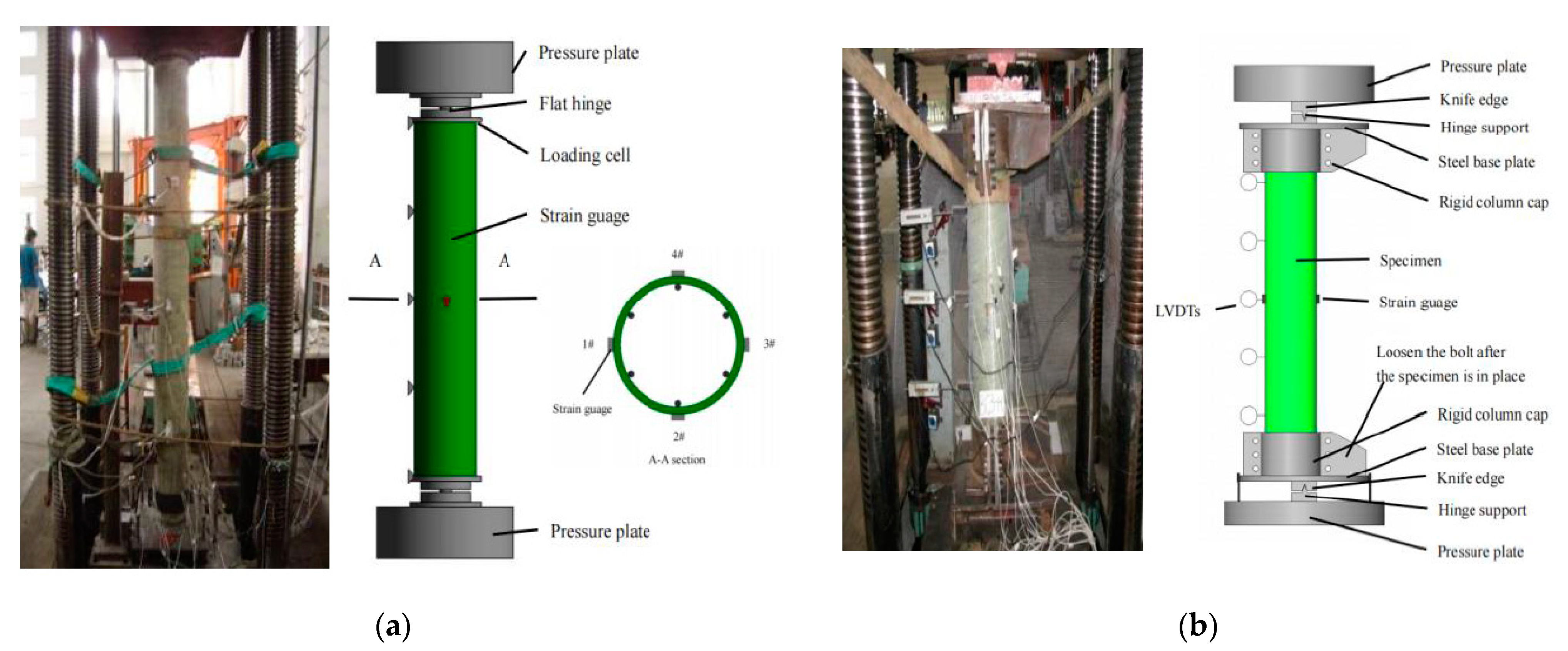
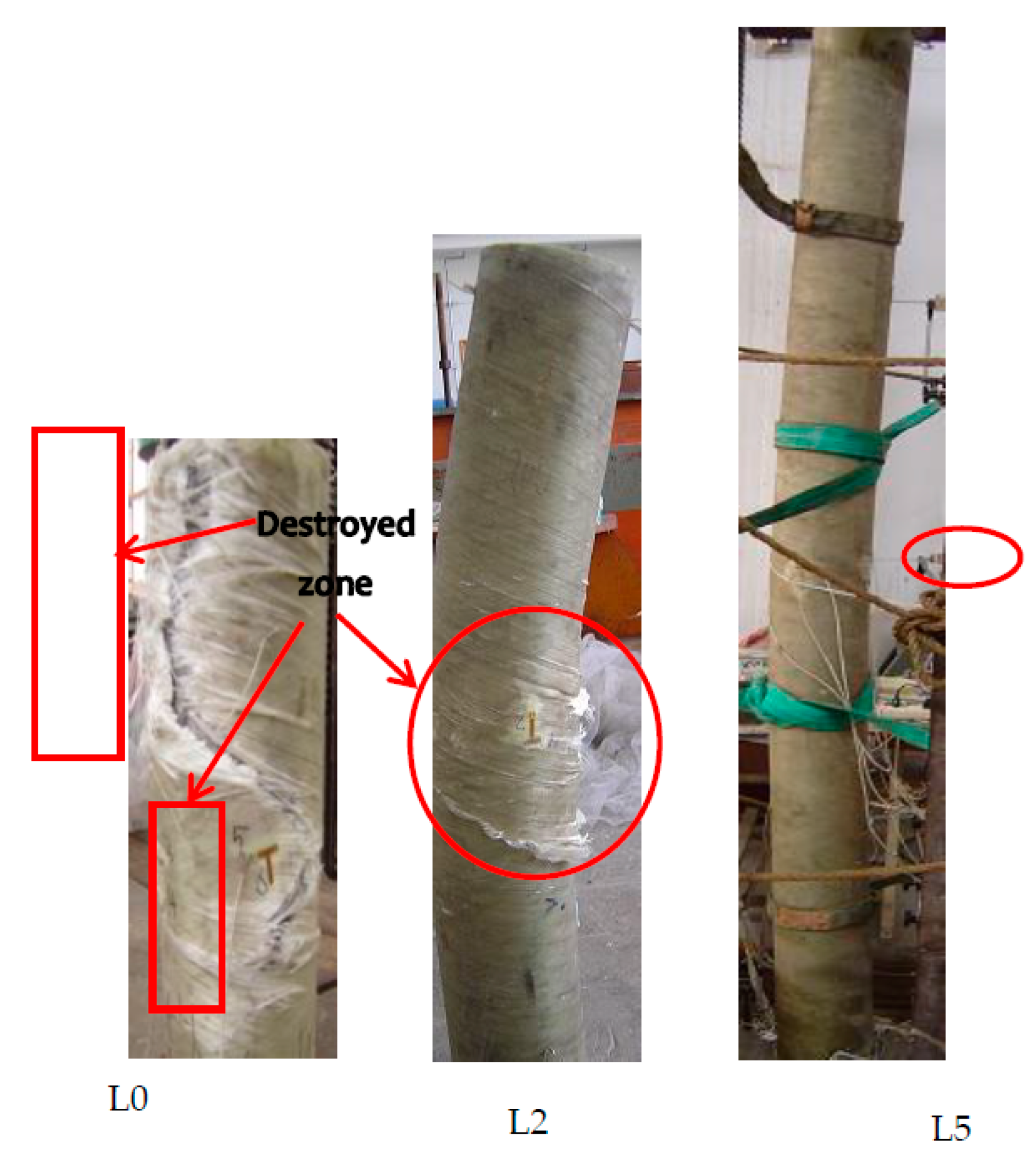

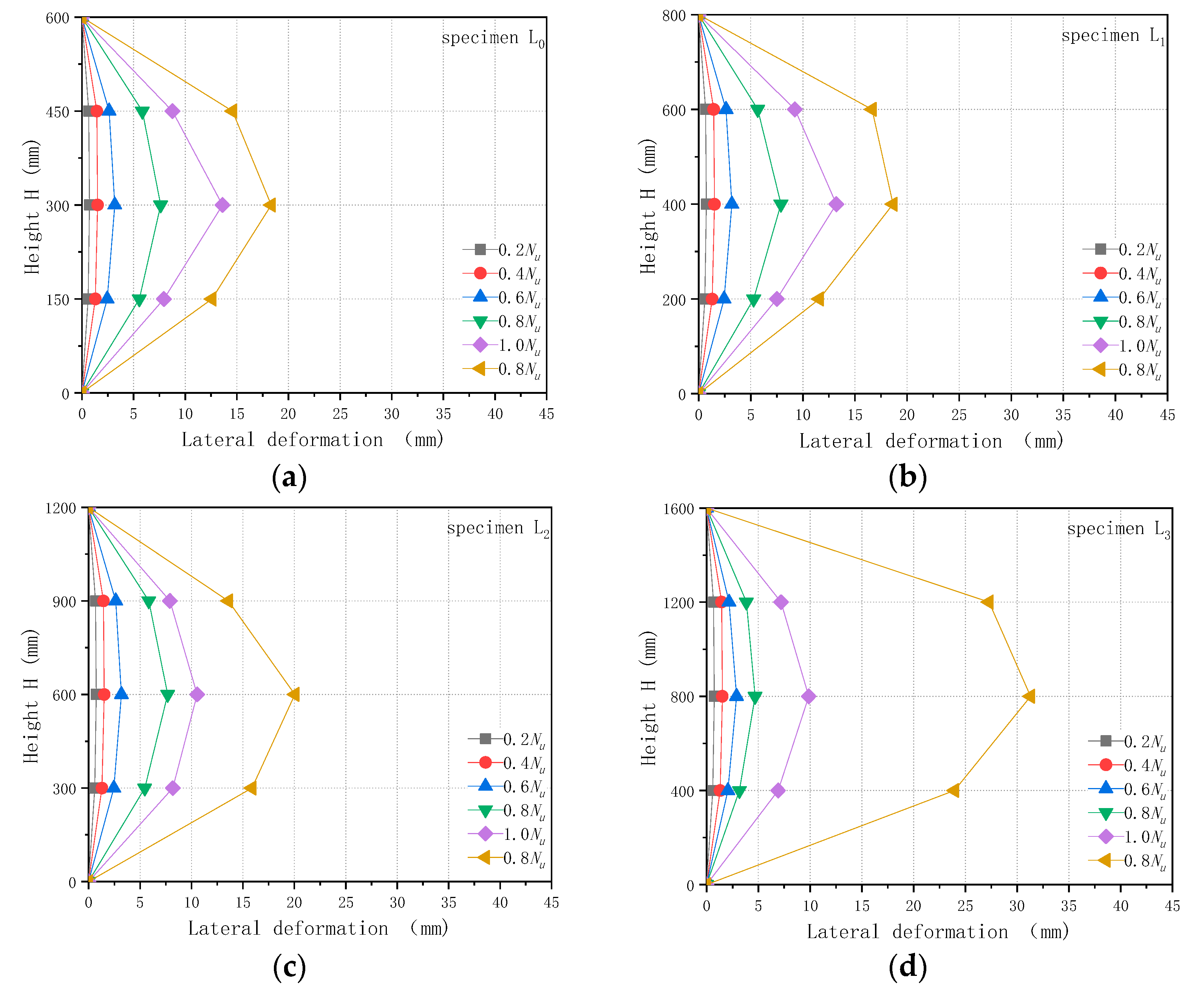

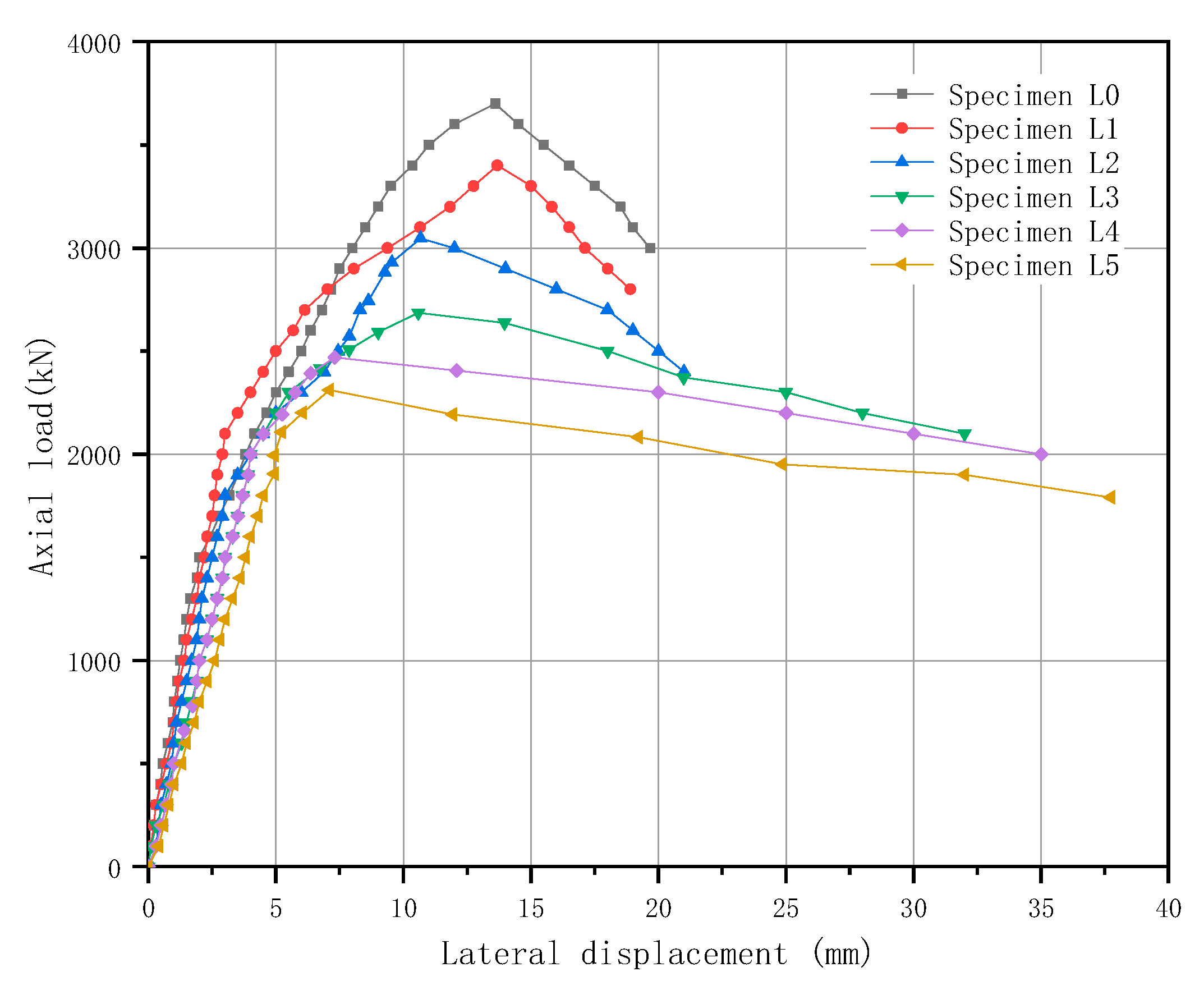
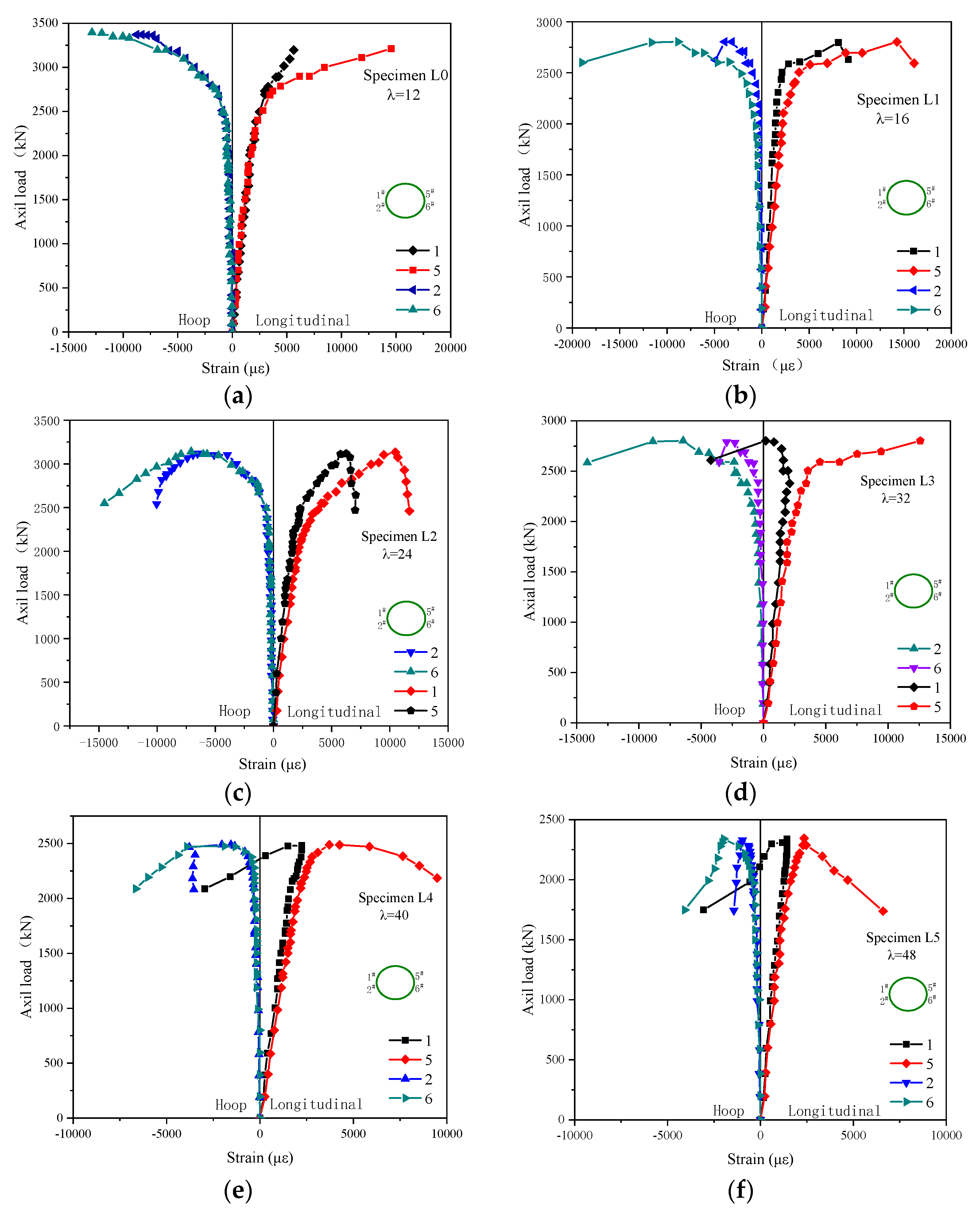
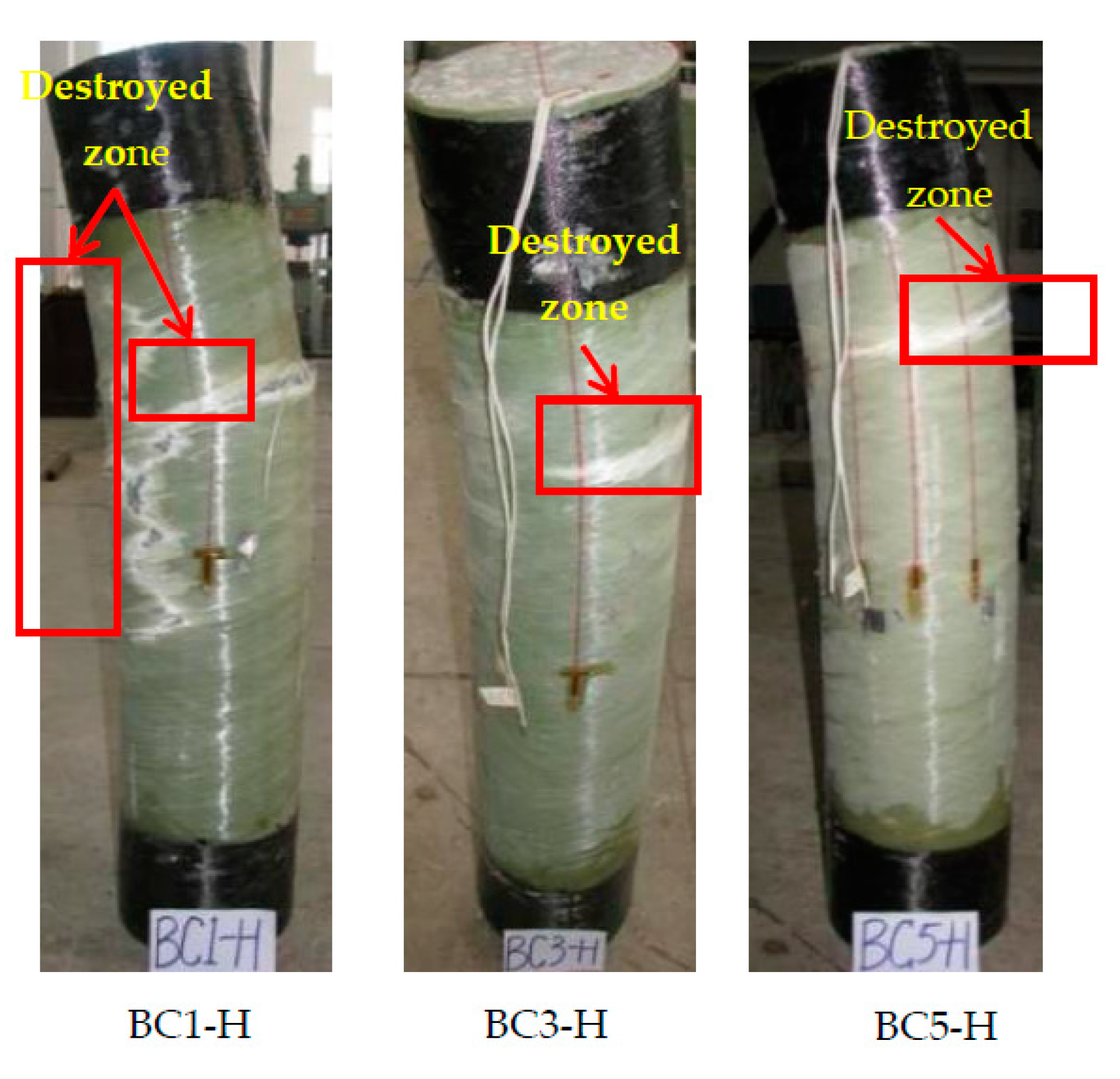
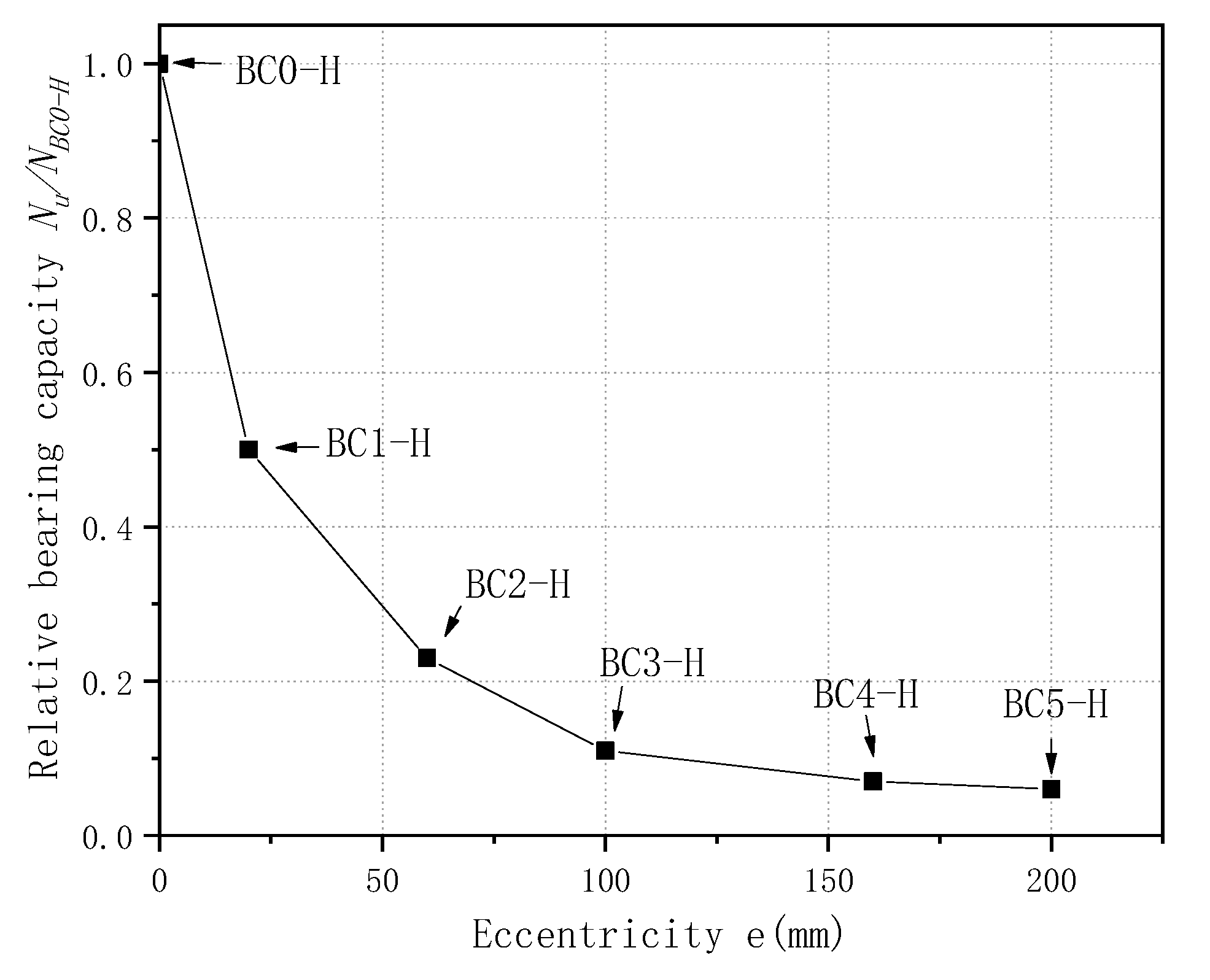

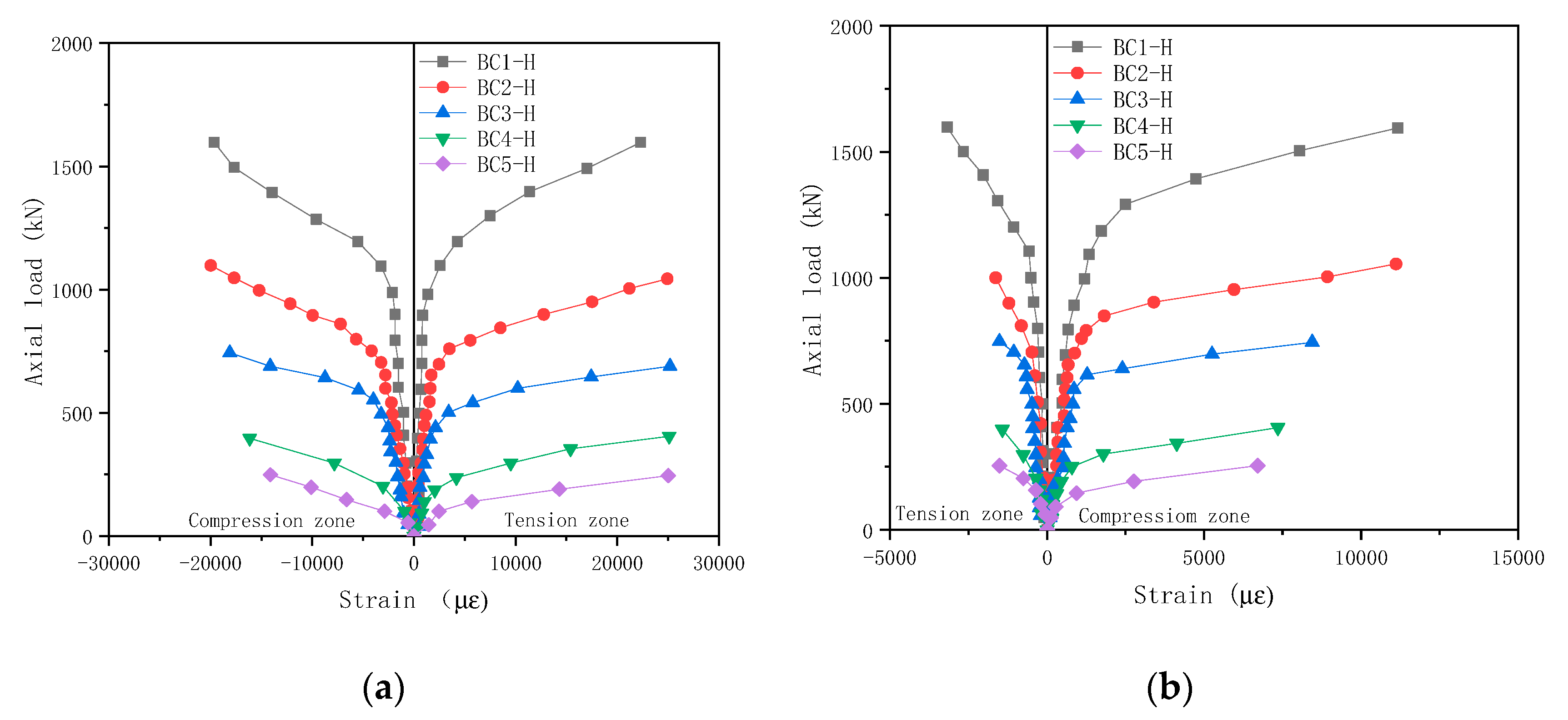

| Serial | Specimen ID | Height l0 (mm) | Slenderness Ratio λ | Eccentricity (mm) | Eccentricity Ratios e/D | Peak Load (kN) | Reduction in Peak Load (%) | Lateral Deformation at Peak Load (mm) |
|---|---|---|---|---|---|---|---|---|
| Series A | L0 | 600 | 12 | 0 | 0 | 3720.27 | - | 13.60 |
| L1 | 800 | 16 | 0 | 0 | 3454.50 | 7.14 | 13.21 | |
| L2 | 1200 | 24 | 0 | 0 | 3115.70 | 16.25 | 10.56 | |
| L3 | 1600 | 32 | 0 | 0 | 2740.67 | 26.33 | 9.86 | |
| L4 | 2000 | 40 | 0 | 0 | 2568.64 | 30.96 | 6.43 | |
| L5 | 2400 | 48 | 0 | 0 | 2390.63 | 35.74 | 5.67 | |
| Series B | BC0-H | 1000 | 0 | 0 | 0 | 3288.80 | - | 13.03 |
| BC1-H | 1000 | 20 | 20 | 0.1 | 1644.75 | 49.99 | 25.37 | |
| BC2-H | 1000 | 20 | 60 | 0.3 | 742.54 | 77.42 | 30.02 | |
| BC3-H | 1000 | 20 | 100 | 0.5 | 359.69 | 89.06 | 33.93 | |
| BC4-H | 1000 | 20 | 160 | 0.8 | 215.36 | 93.45 | 36.35 | |
| BC5-H | 1000 | 20 | 200 | 1.0 | 183.46 | 94.44 | 40.35 |
| Reinforcement Type | Nominal Diameter (mm) | Tensile Modulus of Elasticity (GPa) | Yield Strength (MPa) | Ultimate Strength (MPa) | Yield Strain (%) |
|---|---|---|---|---|---|
| Hoop reinforcement | 6.5 | 210 | 355 | 415 | 0.20 |
| longitudinal reinforcement | 12 | 200 | 385 | 509 | 0.18 |
| Circumferential Tensile Strength (MPa) | Axial Tensile Strength (MPa) | Hoop Elastic Modulus (MPa) | Axial Elastic Modulus (MPa) |
|---|---|---|---|
| 430 | 156 | 24,610 | 9760 |
| Source of Data | Specimen Number | Length (mm) | Diameter (mm) | Height-to-Diameter L/D | Slenderness Ratio kL/D | Eccentricity (mm) | Slenderness Reduction Factor | Eccentric Reduction Factor | |||
|---|---|---|---|---|---|---|---|---|---|---|---|
| Literature [28] | 1 | 305 | 147.3 | 2.1 | 4 | 0 | 1 | 1 | 97.41 MPa | 96.36 MPa | 1.011 |
| 2 | 813 | 147.3 | 5.5 | 11 | 0 | 0.82 | 1 | 79.98 MPa | 78.66 MPa | 1.017 | |
| 3 | 1372 | 147.3 | 9.3 | 18 | 0 | 0.65 | 1 | 60.27 MPa | 63.08 MPa | 0.955 | |
| 4 | 1651 | 147.3 | 11.2 | 22 | 0 | 0.52 | 1 | 49.18 MPa | 49.82 MPa | 0.987 | |
| 5 | 2286 | 147.3 | 15.5 | 30 | 0 | 0.39 | 1 | 38.08 MPa | 37.54 MPa | 1.014 | |
| 6 | 2591 | 147.3 | 17.6 | 34 | 0 | 0.34 | 1 | 34.76 MPa | 32.40 MPa | 1.073 | |
| 7 | 2743 | 147.3 | 18.6 | 36 | 0 | 0.31 | 1 | 27.90 MPa | 30.09 MPa | 0.927 | |
| Literature [18] | 8-S-I | 610 | 152 | 4 | 8 | 0 | 1.00 | 1 | 1652 kN | 1678 kN | 0.985 |
| 12-S-I | 912 | 152 | 6 | 12 | 0 | 0.79 | 1 | 1454 kN | 1322 kN | 1.100 | |
| 16-S-I | 1216 | 152 | 8 | 16 | 0 | 0.70 | 1 | 1202 kN | 1175 kN | 1.023 | |
| 20-S-I | 1500 | 152 | 10 | 20 | 0 | 0.63 | 1 | 1127 kN | 1061 kN | 1.062 | |
| Literature [13] | GT-0 | 812 | 203 | 4 | 16 | 0 | 1 | 1 | 1884 kN | 1797 kN | 1.048 |
| GT-25 | 812 | 203 | 4 | 16 | 25 | 1 | 0.503 | 860 kN | 903 kN | 0.952 | |
| GT-50 | 812 | 203 | 4 | 16 | 50 | 1 | 0.307 | 523 kN | 551 kN | 0.949 | |
| Literature [30] | FTRC-0 | 800 | 240 | 3.33 | 6.67 | 0 | 1 | 1 | 1850 kN | 2050 kN | 0.902 |
| FTRC-25 | 800 | 240 | 3.33 | 6.67 | 25 | 1 | 0.619 | 1474 kN | 1268 kN | 1.162 | |
| FTRC-50 | 800 | 240 | 3.33 | 6.67 | 50 | 1 | 0.371 | 1038 kN | 760 kN | 1.365 | |
| Literature [31] | GRC-2 | 700 | 200 | 3.5 | 7 | 20 | 1 | 0.628 | 1344 kN | 1117 kN | 1.203 |
| GRC-3 | 700 | 200 | 3.5 | 7 | 40 | 1 | 0.458 | 841 kN | 814 kN | 1.033 | |
| GRC-4 | 700 | 200 | 3.5 | 7 | 0 | 1 | 1 | 1548 kN | 1778 kN | 0.871 | |
| Literature [29] | Z1-L-5-40 | 1000 | 200 | 5 | 20 | 40 | 0.85 | 0.387 | 1001 kN | 993 kN | 1.008 |
| Z2-L-6-40 | 1200 | 200 | 6 | 24 | 40 | 0.75 | 0.387 | 942 kN | 871 kN | 1.081 | |
| Z3-L-7-40 | 1400 | 200 | 7 | 28 | 40 | 0.69 | 0.387 | 785 kN | 804 kN | 0.976 | |
| Z4-L-9-40 | 1800 | 200 | 9 | 36 | 40 | 0.60 | 0.387 | 719 kN | 698 kN | 1.030 | |
| Z6-H-7-0 | 1400 | 200 | 7 | 28 | 0 | 0.69 | 1.000 | 2526 kN | 2671 kN | 0.946 | |
| Z6-H-7-40 | 1400 | 200 | 7 | 28 | 40 | 0.69 | 0.387 | 1087 kN | 1034 kN | 1.051 | |
| Z6-H-7-60 | 1400 | 200 | 7 | 28 | 60 | 0.69 | 0.247 | 756 kN | 661 kN | 1.144 | |
| Z6-H-7-100 | 1400 | 200 | 7 | 28 | 100 | 0.69 | 0.139 | 414 kN | 372 kN | 1.113 | |
| Z6-H-7-160 | 1400 | 200 | 7 | 28 | 160 | 0.69 | 0.092 | 237 kN | 245 kN | 0.966 | |
| Z6-H-9-40 | 1800 | 200 | 9 | 36 | 40 | 0.60 | 0.387 | 1005 kN | 898 kN | 1.120 | |
| Z6-H-9-160 | 1800 | 200 | 9 | 36 | 160 | 0.60 | 0.092 | 188 kN | 213 kN | 0.883 | |
| Z6-H-5-40 | 1000 | 200 | 5 | 20 | 40 | 0.85 | 0.387 | 1435 kN | 1277 kN | 1.124 | |
| Z6-H-5-160 | 1000 | 200 | 5 | 20 | 160 | 0.85 | 0.092 | 267 kN | 303 kN | 0.881 | |
| Z6-H-6-40 | 1200 | 200 | 6 | 24 | 40 | 0.75 | 0.387 | 1269 kN | 1120 kN | 1.133 | |
| Z6-H-6-160 | 1200 | 200 | 6 | 24 | 160 | 0.75 | 0.092 | 245 kN | 266 kN | 0.922 |
Publisher’s Note: MDPI stays neutral with regard to jurisdictional claims in published maps and institutional affiliations. |
© 2021 by the authors. Licensee MDPI, Basel, Switzerland. This article is an open access article distributed under the terms and conditions of the Creative Commons Attribution (CC BY) license (https://creativecommons.org/licenses/by/4.0/).
Share and Cite
Guan, H.; Xia, Y.; Wang, J.; Mbonyintege, A.H. Influences of Slenderness and Eccentricity on the Mechanical Properties of Concrete-Filled GFRP Tube Columns. Polymers 2021, 13, 2968. https://doi.org/10.3390/polym13172968
Guan H, Xia Y, Wang J, Mbonyintege AH. Influences of Slenderness and Eccentricity on the Mechanical Properties of Concrete-Filled GFRP Tube Columns. Polymers. 2021; 13(17):2968. https://doi.org/10.3390/polym13172968
Chicago/Turabian StyleGuan, Hongbo, Yifei Xia, Jinli Wang, and Arsene Hugo Mbonyintege. 2021. "Influences of Slenderness and Eccentricity on the Mechanical Properties of Concrete-Filled GFRP Tube Columns" Polymers 13, no. 17: 2968. https://doi.org/10.3390/polym13172968
APA StyleGuan, H., Xia, Y., Wang, J., & Mbonyintege, A. H. (2021). Influences of Slenderness and Eccentricity on the Mechanical Properties of Concrete-Filled GFRP Tube Columns. Polymers, 13(17), 2968. https://doi.org/10.3390/polym13172968






